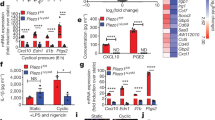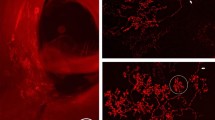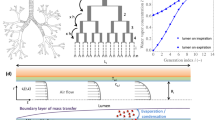Abstract
BOTH birds and mammals possess pulmonary receptors which increase discharge in phase with each inspiration1–5. In mammals the adequate stimulus of these receptors seems to be the total transpulmonary pressure which varies with both inflation volume and rate and sign of the volume change6. The lungs of birds, however, consist of a complex system of air tubes7,8 and unlike those of mammals are relatively inexpansible. Many avian pulmonary receptors have no mechanosensitivity, the adequate stimulus being the changes in airway CO2 throughout the breathing cycle9–12. So rate and degree of inflation of the respiratory system is signalled by different sensory modalities in birds and mammals. The demonstration that mammalian pulmonary receptors are partially inhibited by high alveolar CO2 (refs 13–15) and that some avian receptors may be mechanosensitive16,17 suggests that in the more phylogenetically ancient vertebrate classes it might be possible to locate a pulmonary receptor which has distinct mechano- and chemosensitive properties, thereby allowing speculation on the evolution of the avian and mammalian receptor types.
This is a preview of subscription content, access via your institution
Access options
Subscribe to this journal
Receive 51 print issues and online access
$199.00 per year
only $3.90 per issue
Buy this article
- Purchase on Springer Link
- Instant access to full article PDF
Prices may be subject to local taxes which are calculated during checkout
Similar content being viewed by others
References
King, A. S., Molony, V., McLelland, J., Bowsher, D. R., and Mortimer, M. F., Experientia, 24, 1017–1018 (1968).
Jones, D. R., Comp. Biochem. Physiol., 28, 961–965 (1969).
Fedde, M. R., and Peterson, D. F., J. Physiol., Lond., 209, 609–625 (1970).
Adrian, E. D., J. Physiol., Lond., 79, 332–358 (1933).
Paintal, A. S., Physiol. Rev., 53, 159–227 (1973).
Davis, H. L., Fowler, W. S., and Lambert, E. H., Am. J. Physiol., 187, 558–566 (1956).
King, A. S., Int. Rev. gen. exp. Zool., 2, 171–267 (1966).
Dunker, H. R., Ergebn. Anat. Entw. Gesch., 45, 1–171 (1972).
Fedde, M. R., Gatz, R. N., Slama, H., and Scheid, P., Resp. Physiol., 22, 99–114 (1974).
Fedde, M. R., Gatz, R. N., Slama, H., and Scheid, P., Resp. Physiol., 22, 115–122 (1974).
Osborne, J. L., and Burger, R. E., Resp. Physiol., 22, 77–86 (1974).
Burger, R. E., Osborne, J. L., and Banzett, R. B., Resp. Physiol., 22, 87–98 (1974).
Mustafa, M. E. K. Y., and Purves, M. J., Resp. Physiol., 16, 197–212 (1972).
Schoener, E. P., and Frankel, H. M., Am. J. Physiol., 222, 68–72 (1972).
Sant'Ambrogio, G., Miserocchi, G., and Mortola, J., Resp. Physiol., 22, 191–198 (1974).
Molony, V., Resp. Physiol., 22, 57–76 (1974).
Leitner, L. M., Resp. Physiol., 16, 232–244 (1972).
Lenfant, C., Johansen, K., Petersen, J. A., and Schmidt-Nielsen, K., Resp. Physiol., 8, 261–275 (1970).
Gans, C., and Hughes, G. M., J. exp. Biol., 47, 1–20 (1967).
Gatz, R. N., Fedde, M. R., and Crawford, E. C., Jr, Experientia, 31, 455–456 (1975).
Petersen, D. F., and Fedde, M. R., Science, 162, 1499–1501 (1968).
Bartoli, A., et al., J. Physiol., Lond., 240, 91–110 (1974).
Author information
Authors and Affiliations
Rights and permissions
About this article
Cite this article
MILSOM, W., JONES, D. Are reptilian pulmonary receptors mechano- or chemosensitive?. Nature 261, 327–328 (1976). https://doi.org/10.1038/261327a0
Received:
Accepted:
Published:
Issue Date:
DOI: https://doi.org/10.1038/261327a0
This article is cited by
-
Intrapulmonary receptors in the bullfrog: Sensitivity to CO2
Journal of Comparative Physiology ? A (1979)
-
Carbon dioxide sensitivity of pulmonary receptors in the frog
Experientia (1977)
Comments
By submitting a comment you agree to abide by our Terms and Community Guidelines. If you find something abusive or that does not comply with our terms or guidelines please flag it as inappropriate.



